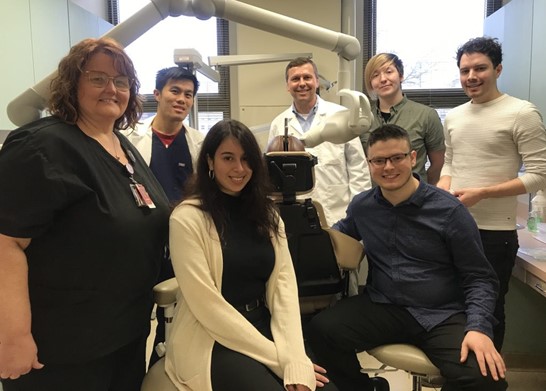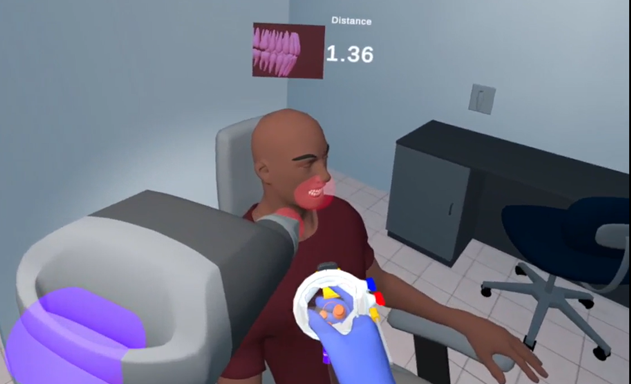Dr. Vinicius Dutra has developed a virtual reality (VR) radiology training for oral health providers, designed to address both the high cost of radiology training and the low interest of many dental students in radiology.
“A virtual reality training module solves multiple issues: education, cost, and motivation,” Dr. Dutra said. “Frankly, hardly anyone goes to dental school for radiology. I think that the VR headset communicates with and motivates the students in a way that is impossible for traditional, analog techniques.”
Additionally, training radiologists is expensive. A single mannequin used to practice the X-ray process can cost over $15,000, and the repair of expected wear-and-tear on the mannequin can cost a few thousand more.
VR, created by an immersive piece of headgear and sleek handheld controllers, puts the user in a virtual world, devoid of outside distractions. Dr. Dutra realized the potential of this technology, and created a dental exam room in VR, complete with an X-ray machine.
Along with the efforts of Dr. Dutra and Oral Pathology, Medicine, and Radiology colleague Dr. Phillip Wong, members of multiple IUPUI schools collaborated on this project. Professor Zebulun Wood and Drennen Dooms from the Luddy School of Informatics, Computing, and Engineering at IUPUI joined in on the project, along with multiple art students.
Wood and Dooms replicated both the objects and space within a dental office and the complex interactions and choices that a dentist navigates during patient care.
This virtual examination room contains the machine, as well as tools, display screens, and other instrument panels. Once logged in, the user has full control over the machine and attachments needed to complete the radiology scan.
“VR is perfect for training in spatial tasks; it may be more effective than two-dimensional educational tools like books, video, or online training on a computer monitor,” Professor Wood said. “We had a blast working with Dr. Dutra and can't wait to see the results from the study!”
“This technology allows someone to learn at their own pace, on their own time, wherever it is convenient,” Dr. Dutra said. “Someone training on VR can step into an examination room for the first time, and it won’t feel strange. Not to mention, no harmful radiation or expensive mannequins.”
Now in its third year of development, Dr. Dutra envisions the technology taking off once completed. "If you can build an X-ray room to practice in, what’s stopping it from being used to practice neurosurgery? The possibilities are as endless as the VR world you enter when you don the headset,” he said.
A Curriculum Enhancement Grant from the Center for Teaching and Learning at IUPUI funded this project development. The study still needs three student volunteers. Contact Dr. Dutra to try out this new technology before next year’s incoming class trains on it.

(L-R) Dental Assistant Kathy Cornett, Dr. Phillip Wong, Yasmine Mestaghami, Dr. Vinicius Dutra, Justin Tidwell (front), Brett Phelps (back), Devin Norcross pose with the machine they intend to emulate in VR.



